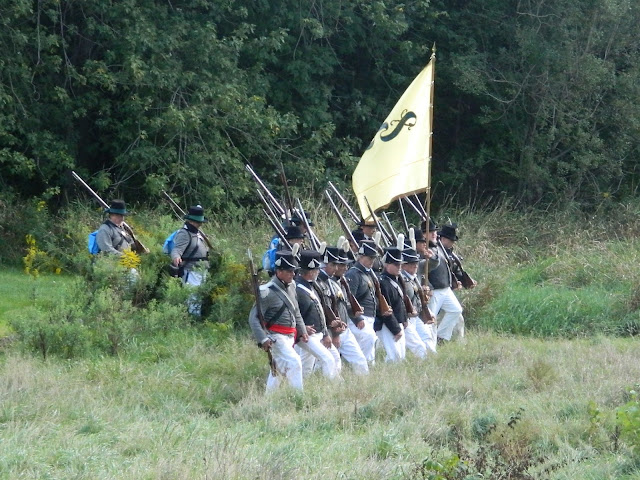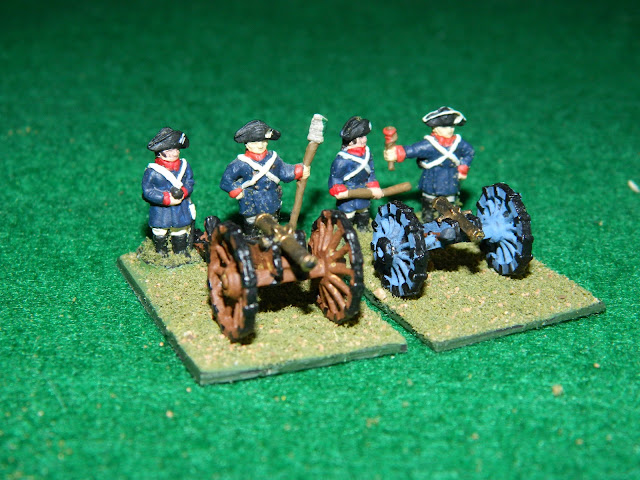The reenacting season is winding down, although a huge one is yet to come - the reenactment of the battle of Queenston Heights in October. Even though things are slowing down, there was a fun event last weekend at Backus Mills Conservation Area and Heritage Village in Ontario. We almost didn't make it because the weather report was quite threatening and it poured cats and dogs the night before. Still, Saturday morning dawned bright and cool, so Beth, Rob, and I went. (Katie stayed home to celebrate her 21st birthday with friends. Who can figure these things?)
We arrived expecting to set up our tent and found that some other tents had collapsed during the night's storm. Our friends from the 16th US and the 21st US convinced us to leave our canvas in the van and accept their hospitality under their canvas. We didn't argue because very little is better than leaving a reenactment with dry tentage! We had "bought in" for the dinner Carrie and Mark were preparing (a wonderful chicken stew and apple crisp cooked over the campfire. I know the troops didn't eat this well in 1812, but we sure eat well!)
The afternoon battle was set for 2:00pm, but at 1:00, the "Iron Man" competition was held. The participants had to pile their kit on a blanket and go back to the start. They ran down a hill, vaulted a low fence, put on their kit, ran back up the hill, jumped over the fence, fire three shots (ramming the powder as well), ran down the hill (fence again), fix bayonets and jab an appropriately uniformed dummy, back up the hill and fence, drink a mug of water and hold it over their heads at the finish line. This was all timed!
 |
| Rob heads down the hill on the first leg. His kit is laid out on the white blanket by the tree. |
 |
| Kitting up. |
 |
| Three rammed shots. Rob only got one off, with two misfires, which gave him a 15 second penalty. |
 |
| Up the hill after bayonetting the red coated dummy. |
 |
| A serious gulp! It's hard to drink and pant! |
Our Rob came in third... not bad for a first timer! There were only a few seconds between him and the second place. If his musket had fired, he might have won.
The afternoon battle saw Rob skirmishing with the 16th/21st and I was detailed to be the commander's bodyguard and bugler. (Our good friend, Paul, was overall commander with the rank of major.) I'm learning the bugle calls for the US light infantry from William Duane's 1812 "Handbook for Riflemen" which contains about 60 bugle calls for the US forces. My old India Pattern bugle will serve, although there's some controversy over whether the British pattern or the more Germanic Jaegerhorn pattern was used by the US. Well, I have a paid-for bugle and 40+ years playing brass insturments... so now I AM the "Minstrel Boy"!
The US forces entered the field after a cannon bombardment and we pushed the Crown forces hard, so hard we were told we were moving too fast and if we captured one certain cannon, the Crown forces were set to use that as a signal to withdraw. The 1st US Rifles took it anyway. I could see their hatchets (rubber ones) flailing away over the gun crew. Lots of fire was exchanged and the US held the day for the afternoon.
 |
| Skirmishers from the 16th, 17th (Rob), 21st (Mark), and the 1st Rifles (extreme right, in green) take the field. |
 |
| The commander of the British Indian Department troops in full skulk. He commanded reenactors dressed as Native warriors and British troops in green hunting frocks and tams. The officers of the BID dressed in red so they would not be shot by the Natives, who might think they were Americans. |
 |
Skirmisher from the 25th US and the 1st Kentucky Rifle Volunteers doing proper light infantry tactics.
James of the 16th is on the extreme right. |
 |
The 22nd US advances in line with the Canadian Volunteers just behind them. (Top hats with green hat band.)
The 16th NY Volunteers are just beyond the 22nd. Everybody in this crowd was in grey jackets. |
 |
| Paul and I with our intrepid runner, Charlie, as we all survey the battlefield. I look rather stunned for some reason. |
 |
| Jonesy, Rob, and Mark await the order to fire. |
 |
| Battalion volley! |
 |
| Jonesy, Roby, and Mark now HAVE the order to fire! |
 |
| British Forces in line and in the shade. Maybe that's why they were so hard to move! |
 |
| Another view of the British line. Some of the sergeants carry muskets or shorter musketoons, some carry spontoons (the boar spear-like weapon). I suppose it's a matter of taste, but I've read that many of the NCO's in North America carried a musket since the spontoon was so cumbersome. US sergeants carried muskets. Sergeants major on both sides did damage by force of personality... like they do today. |
 |
Rob in the act of loading. He'll go through a box of 36 cartridges in one engagement as light infantry.
He's learning to fire fast, maybe faster than he needs to. (Powder isn't cheap!) |
 |
I prepare to fire my one shot of the afternoon. Note the proper method of cocking the musket. ("I am the very model of..." "Oh, shut up!") As bodyguard/bugler, I fired one shot and played one call. I also carried Charlie into the shade when he "took a hit." Our friend, Phil, is in the foreground in his huge chapeau bras.
James, commanding the 16th walks behind me. |
The second battle was in the evening. (after a fine dinner. Thanks, Carre!) I was bodyguard/bugler again and this time I was told to play random calls and even to mimic the British calls in order to confuse them. It didn't work. We exchanged volleys on the Conservation Area's bridge while the lights skirmished in a hollow off to the side. The British were rather aggressive that evening and we finally withdrew by "leap-frogging" unit from unit, most of the way up the hill. Afterwards, the traditional march-past took place.
 |
| Paul and I await the assembly of the US forces... who -as usual and under orders- "gaggled over." |
 |
| Troops of the BID scout the field. |
 |
| Crown boat-men rowed around the pond while pyrotechnics made noise and smoke and the cannons fired. |
 |
| A Yankee unit gives fire on the bridge. |
 |
The 22nd US, the 16th NY, and the Canadian Volunteers advance toward the bridge.
Phil is now in shako with his double-barreled carbine! |
 |
| British skirmishers in the hollow off to the side of the bridge. My wife took all these photos and did a good job of getting a view through the underbrush. |
 |
| As the 22nd prepares to volley, Paul talks to the Rifle commander. Note the young drummer of the 22nd. |
 |
The US retreat begins as the colour party falls back. The 16th NY begins the holding action.
The white litter on the road is spend cartridge papers. Yes, we tear them open with out teeth in best 1812 style!
Nothing beats a mouthful of black powder. |
 |
| As dusk falls and musket smoke clouds our vision. the Crown forces advance. |
 |
| One last blast from the 22nd. I though Rob was in the photo with his metal "kidney" canteen, but I'm sure now that he isn't in the photo; his crossbelts are black. I fell "wounded" about this time, wrapping my leg in a rag and ducking the British volleys. {Elevate, boys, elevate!} |
On the whole, the day was well planned and executed. The setting is very nice and quite a few people came out to visit. Since the day was cool, I was in my blue wool all day - unusual for me since the heat bothers me a lot. Next, we have a display at the Anglican Cathedral in London later this month and the reenactment of the battle of Queenston Heights in October. Then we'll settle down to "winter quarters." This winter, Rob and I hope to make those peaked fatigue caps for ourselves. My fatigue cap is made from an old shirt and oddly, gets larger and larger as I perspire. I don't know why.






























































